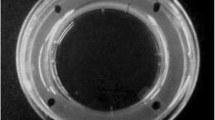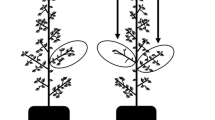Abstract
We examined the effects of CO2-mediated changes in the foliar chemistry of paper birch (Betula papyrifera) and white pine (Pinus strobus) on performance of the gypsy moth (Lymantria dispar). Trees were grown under ambient or enriched CO2 conditions, and foliage was subjected to plant chemical assays and insect bioassays. Enriched CO2 atmospheres reduced foliar nitrogen levels and increased condensed tannin levels in birch but not in pine. Foliar carbohydrate concentrations were not markedly altered by CO2 environment. Gypsy moth performance was significantly affected by CO2 level, species, and the CO2 x species interaction. Under elevated CO2 conditions, growth was reduced for larvae fed birch, while development was prolonged for larvae fed pine. Although gypsy moths performed better overall on birch than pine, birch-fed larvae were influenced more by CO2-mediated changes in host quality.
Similar content being viewed by others
References
Ayres MP (1993) Plant defense, herbivory, and climate change. In: Kingsolver JG, Kareiva PM, Huey RB (eds) Biotic interactions and global change. Sinauer, Sunderland MA, pp 75–94
Barbosa P (1978) Host plant exploitation by the gypsy moth, Lymantria dispar. Entomol Exp Appl 24: 228–237
Bazzaz FA, Chiariello NR, Coley PD, Pitelka LF (1987) Allocating resources to reproduction and defense. Bioscience 37: 58–67
Bradford MM (1976) A rapid and sensitive method for the quantitation of microgram quantities of protein utilizing the principle of protein-dye binding. Anal Biochem 72: 248–254
Bryant JP, Chapin FS III, Klein DR (1983) Carbon/nutrient balance of boreal plants in relation to vertebrate herbivory. Oikos 40: 357–368
Bryant JP, Chapin FS III, Reichardt PB, Clausen TP (1987) Response of winter chemical defense in Alaska paper birch and green alder to manipulation of plant carbon/nutrient balance. Oecologia 72: 510–514
Coley PD, Bryant JP, Chapin FS III (1985) Resource availability and plant antiherbivore defense. Science 230: 895–899
Dustin CD, Cooper-Driver GA (1992) Changes in phenolic production in the hay-scented fern (Dennstaedtia punctilobula) in relation to resource availability. Biochem Syst Ecol 20: 99–106
Elias TS (1980) The complete trees of North America. Times Mirror Magazines, New York
Herms DA, Mattson WJ (1992) The dilemma of plants: to grow or defend? Q Rev Biol 67: 283–335
Iason GR, Hester AJ (1993) The response of heather (Calluna vulgaris) to shade and nutrients-predictions of the carbon-nutrient balance hypothesis. J Ecol 81: 75–80
Jones CG, Hare JD, Compton SJ (1989) Measuring plant protein with the Bradford assay. J Chem Ecol 15: 979–992
Kramer PJ (1981) Carbon dioxide concentration, photosynthesis, and dry matter production. Bioscience 31: 29–33
Lang CA (1958) Simple microdetermination of Kjeldahl nitrogen in biological materials. Anal Chem 30: 1692–1694
Larsson S, Wirén A, Lundgren L, Ericsson T (1986) Effect of light and nutrient stress on leaf phenolic chemistry in Salix dasyclados and susceptibility to Galerucella lineola (Coleoptera). Oikos 47: 205–210
Lechowicz MJ, Mauffette Y (1986) Host preferences of the gypsy moth in eastern North American versus European forests. Rev Entomol Quebec 31: 43–51
Lincoln DE, Fajer ED, Johnson RH (1993) Plant-insect herbivore interactions in elevated CO2 environments. Trends Ecol Evol 8: 64–68
Lindroth RL, Kinney KK, Plantz CL (1993) Responses of deciduous trees to elevated atmospheric CO2: productivity, phytochemistry and insect performance. Ecology 74: 763–777
Mihaliak CA, Gershenzon J, Croteau R (1991) Lack of rapid monoterpene turnover in rooted plants: implications for theories of plant chemical defense. Oecologia 87: 373–376
Mirov NT (1967) The Genus Pinus. Ronald, New York
ODell TM, Butt CA, Bridgeforth AW (1985) Lymantria dispar. In: Singh P, Moore RF (eds) Handbook of insect rearing, vol. 2. Elsevier, New York, pp 355–367
Parkinson JA, Allen SE (1975) A wet oxidation procedure suitable for the determination of nitrogen and mineral nutrients in biological material. Commun Soil Sci Plant Anal 6: 1–11
Porter LJ, Hrstich LN, Chan BG (1986) The conversion of procyanidins and prodelphinidins to cyanidin and delphinidin. Phytochemistry 25: 223–230
Raffa KF, Steffeck RJ (1988) Computation of response factors for quantitative analysis of monoterpenes by gas-liquid chromatography. J Chem Ecol 14: 1385–1390
Reichardt PB, Chapin III FS, Bryant JP, Mattes BR, Clausen TP (1991) Carbon/nutrient balance as a predictor of plant defense in Alaskan balsam poplar: potential importance of metabolite tornover. Oecologia 88: 401–406
Rossiter MC (1987) Use of secondary host by non-outbreak populations of the gypsy moth. Ecology 68: 857–868
SAS Institute (1989) SAS user's guide: statistics, version 6 ed. SAS Institute Inc, Cary NC
Scriber JM (1977) Limiting effects of low-water content on the nitrogen utilization, energy budget, and larval growth of Hyalophora cecropia (Lepidoptera: Saturniidae). Oecologia 28: 269–287
Tuomi J, Niemala P, Chapin FS, Bryant JP, Sirin S (1988) Defensive responses of trees in relation to their carbon/nutrient balance. In: Mattson WJ, Levieux J, Bernard-Dagan C (eds) Mechanisms of woody plant defenses against insects: search for pattern, Springer, New York, pp 57–72
Waldbauer GP (1968) The consumption and utilization of food by insects. Adv Insect Physiol 5: 229–288
Author information
Authors and Affiliations
Rights and permissions
About this article
Cite this article
Roth, S.K., Lindroth, R.L. Effects of CO2-mediated changes in paper birch and white pine chemistry on gypsy moth performance. Oecologia 98, 133–138 (1994). https://doi.org/10.1007/BF00341464
Received:
Accepted:
Issue Date:
DOI: https://doi.org/10.1007/BF00341464




